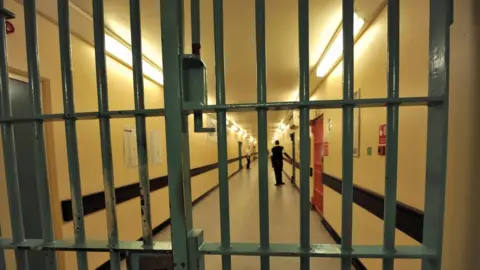Women's prisons: Fresh doubts over government plans
 Getty Images
Getty ImagesFresh doubts have emerged about government plans to overhaul the way female offenders are dealt with in England and Wales.
The Ministry of Justice has refused to say whether it'll fulfil a pledge it made to build and open five new "community prisons" for women by 2020.
The department has also delayed a female offender strategy that was due to come out a year ago.
And it's emerged that plans for 10,000 new prison places for men are well behind schedule.
The revelations come as new figures show the prison population is at its lowest level for more than seven years, with increasing numbers of offenders let out early on electronic tags.
The plans for a network of small community women's prisons, to address their specific needs, were set out in November 2016 in the Ministry of Justice White Paper, "Prison Safety and Reform".
The document said: "They will mean that more women are held closer to their homes and given the support services they need to help them address what are often multiple and complex needs. Within these prisons there will be very close links with the providers of services in the community."
This week, the department declined to say whether it remained committed to the community prisons, which were due to open by the end of 2020. A female offender strategy originally slated for early 2017 has also been postponed.
"Our female offender strategy, focused on improving outcomes for women in the community and custody, will be released in the coming months," said a Ministry of Justice spokesperson.
The department had also promised to "invest £1.3bn to build up to 10,000 new adult prison places" by the end of 2020, enabling the closure of poorly maintained and expensive-to-run Victorian jails.
But the only new building work to have started since the White Paper is on the site of Stocken Prison, Rutland, where a new house block will provide 206 places.

Planning permission has been granted for new jails on land at Glen Parva prison, Leicestershire; Wellingborough, Northamptonshire; and Full Sutton, Yorkshire, but no construction work has begun yet.
Berwyn Prison, Wrexham, which opened in February 2017, has been in development since 2014.
Officials acknowledged there'd been delays in the prison building programme but said the department remained "committed" to providing 10,000 additional prison places.
The delays are partly because of changes at the top of the department since the policy was announced. Liz Truss, the justice secretary at the time, was replaced after the 2017 general election by David Lidington, who was himself moved after a cabinet reshuffle in January this year, with David Gauke taking charge.
The Ministry of Justice is also facing substantial budget cuts, with its funding from the Treasury expected to fall by 11% between 2015-16 and 2019-20 - a reduction of nearly £1bn.
 Reuters
ReutersThe priorities at the department appear to have shifted too, with a dramatic decline in the jail population. There are currently 83,534 people locked up - down almost 3,000 since numbers peaked in August 2017 and the lowest level since January 2011, when there were 83,305 in custody.
The reduction has been driven by a rapid rise in the number of inmates released early on electronic tags, under a scheme known as "Home Detention Curfew" (HDC).
HDC is available for some categories of offender, sentenced to at least three months' imprisonment. They're freed between two weeks and four-and-a-half months before their automatic release date and have to wear a tag and abide by a curfew.
In February, it emerged that ministers had simplified the rules around granting HDC to ensure it became a "normal part of release" because only a fifth of eligible offenders were being let out.
The HDC programme is not available for sex offenders, people convicted of terrorism offences and certain violent criminals.
According to today's figures there are 3,180 ex-prisoners on HDC - an increase of more than 1,000 in eight months.
The rise in the use of HDC only partially explains the reduction in the prison population. It's thought that speeches and statements from ministers, encouraging magistrates and judges to make more use of community sentences, may also have played a part.
